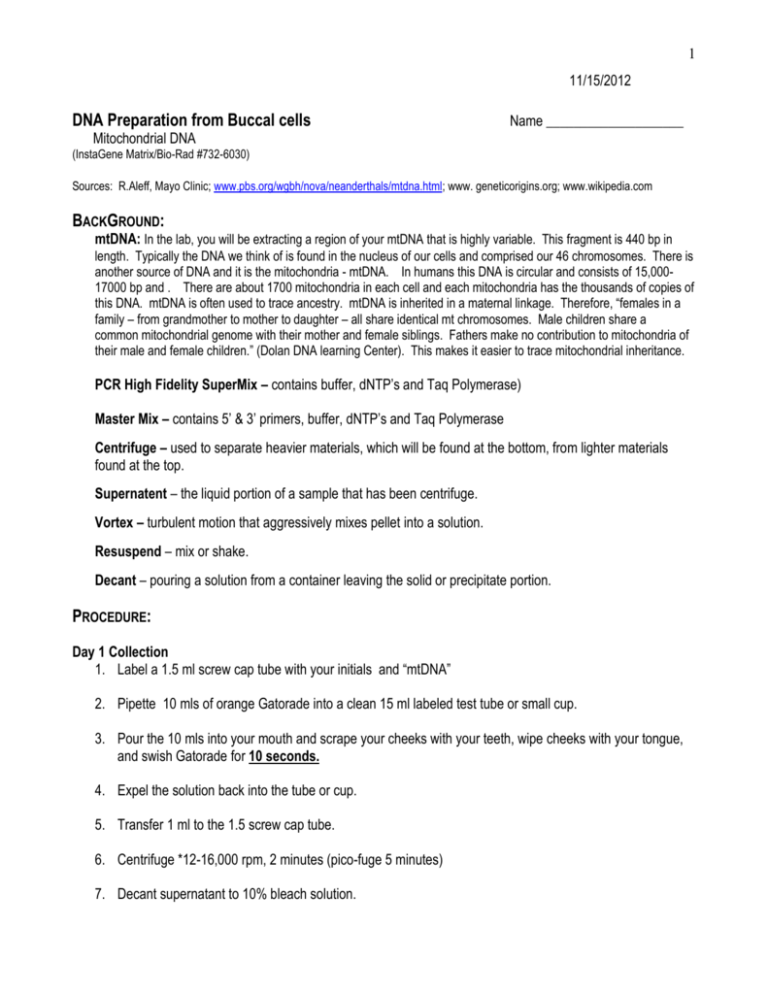DNA Preparation from Buccal cells
advertisement

1 11/15/2012 DNA Preparation from Buccal cells Name ____________________ Mitochondrial DNA (InstaGene Matrix/Bio-Rad #732-6030) Sources: R.Aleff, Mayo Clinic; www.pbs.org/wgbh/nova/neanderthals/mtdna.html; www. geneticorigins.org; www.wikipedia.com BACKGROUND: mtDNA: In the lab, you will be extracting a region of your mtDNA that is highly variable. This fragment is 440 bp in length. Typically the DNA we think of is found in the nucleus of our cells and comprised our 46 chromosomes. There is another source of DNA and it is the mitochondria - mtDNA. In humans this DNA is circular and consists of 15,00017000 bp and . There are about 1700 mitochondria in each cell and each mitochondria has the thousands of copies of this DNA. mtDNA is often used to trace ancestry. mtDNA is inherited in a maternal linkage. Therefore, “females in a family – from grandmother to mother to daughter – all share identical mt chromosomes. Male children share a common mitochondrial genome with their mother and female siblings. Fathers make no contribution to mitochondria of their male and female children.” (Dolan DNA learning Center). This makes it easier to trace mitochondrial inheritance. PCR High Fidelity SuperMix – contains buffer, dNTP’s and Taq Polymerase) Master Mix – contains 5’ & 3’ primers, buffer, dNTP’s and Taq Polymerase Centrifuge – used to separate heavier materials, which will be found at the bottom, from lighter materials found at the top. Supernatent – the liquid portion of a sample that has been centrifuge. Vortex – turbulent motion that aggressively mixes pellet into a solution. Resuspend – mix or shake. Decant – pouring a solution from a container leaving the solid or precipitate portion. PROCEDURE: Day 1 Collection 1. Label a 1.5 ml screw cap tube with your initials and “mtDNA” 2. Pipette 10 mls of orange Gatorade into a clean 15 ml labeled test tube or small cup. 3. Pour the 10 mls into your mouth and scrape your cheeks with your teeth, wipe cheeks with your tongue, and swish Gatorade for 10 seconds. 4. Expel the solution back into the tube or cup. 5. Transfer 1 ml to the 1.5 screw cap tube. 6. Centrifuge *12-16,000 rpm, 2 minutes (pico-fuge 5 minutes) 7. Decant supernatant to 10% bleach solution. 2 8. Completely dry pellet using micro-pipette. (If pellet is slimy and loose repeat step 5&6 with new tube). 9. Decant supernatant to 10% bleach solution. (Pellet should be compact). 10. Resuspend InstaGene mix and add 500 ul to cell pellet and resuspend. 11. Keep in refrigerator until the next day or move on to Day 2 Extraction Day 2 Extraction 12. Vortex InstaGene & cell pellet mixture. 13. Incubate at 56°C for 15 minutes. (Use Heating blocks)(Optional boiling only seems to work). 14. Vortex at high speed 10 seconds. 15. Heat tube at 100°C for 10 minutes (Use heating block)or boiling water bath. 16. Vortex at high speed 10 seconds. 17. Centrifuge pellet *12-16,000 rpm, 3 minutes. (pico-fuge 7.5 minutes) 18. Save the supernatant to a new 1.5 ml tube and label with your name, date, and mtDNA. 19. Store in freezer (long term) or refrigerator (2 weeks). * a clinical centrifuge run @2000 rpm for 10 minutes can be substituted. Day 3 PCR & Pour Gel (Pre-made E-gel can be used for this) 20. Use 5 ul of DNA for each PCR reaction. Set up PCR as follows: PCR Tube - .5 ml or .2 ml machine dependent MASTER MIX for 10 STUDENTS 23 µl of PCR SuperMix High Fidelity (Invitrogen) 5 µl of your mtDNA 1 µl of 5’ Primer 1-10 picomoles/ul 1 µl of 3’ Primer 1-10 picomoles/ul 253 µl of PCR SuperMix High Fidelity (Invitrogen) 0 µl of your mtDNA 11 µl of 5’ Primer 1-10 picomoles/ul 11 µl of 3’ Primer 1-10 picomoles/ul 21. PCR Program 1 cycle 50 cycles 1 cycle Hold Hot Start Amplification Polishing Cold 94-95 °C 94-95 °C 50 °C 68 °C 68 °C 4 °C 275.0 µl total (take 25 µl to each PCR tube and have students add 5 µl of their mtDNA preparation. Add 50 µl of light white mineral oil if you have a heated block only machine. 4 minutes 1 minute 1 minute 1 minutes 7-10 minutes infinity 22. Pour 1.0 % Agarose gel and store under buffer overnight. (Pre-made E-gel can be used for this) 3 23. Remove oil using parafilm method (if you added oil in #20.) Day 4 Run Gel, Analyze Sequence, (& Exo-SAP) 24. Save the aqueous PCR sample in a new tube. 25. Take 15 µl of PCR reaction to another new tube and add 5 µl of tracking dye and load to gel. 26. Load size standard to gel and run gel for 30 minutes at 120 constant voltage. 27. Fragment size should be around 440 bp. If you have product proceed to Exo- SAP treatment. 28. Exo-SAP Treatment Combine in a PCR tube 5 µl PCR product 2 µl Exo-SAP (7 µl Total volume) Incubate at 37 C for 15 minutes. Incubate at 80 c for 15 minutes 29. To prepare fragment for Sequencing: Label a 0.2 ml Sequencing MicroAmp tube with teachers 3 initials and #1-30, a separate # for each student) Keep a log of student samples. Add 5 µl of the Exo-SAP treated PCR mix Add 1 µl of 5’ Primer (1.6 picomoles) Send to Mayo Clinic. Day 5 Alignment of Sequence Data 30. Alignment software at http://www.ncbi.nlm.nih.gov/ 31. Alignment software at http://www.geospiza.com/Products/finchtv.shtml






